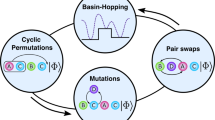Abstract
The present paper is concerned with the rapid solution of a boundary integral equation for the apparent surface charge which arises from solvation continuum models. In order to apply the wavelet Galerkin scheme the molecular surface needs to be represented as a parametric surface consisting of smooth four-sided patches. We develop an algorithm which decomposes a solvent excluded surface into a set of globally continuous four-sided NURBS patches. Numerical experiments are carried out to demonstrate the feasibility and scope of the present approach.
Similar content being viewed by others
References
Bajaj C, Xu G, Zhang Q (2009) A fast variational method for the construction of adaptive resolution C 2 smooth molecular surfaces. Comput Methods Appl Mech Eng 198: 1684–1690
Beylkin G, Coifman R, Rokhlin V (1991) The fast wavelet transform and numerical algorithms. Commun Pure Appl Math 44: 141–183
Brunnett G (1995) Geometric design with trimmed surfaces. Comput Suppl 10: 101–115
Cancés E, Mennucci B (1998) New applications of integral equations methods for solvation continuum models: ionic solutions and liquid crystals. J Math Chem 23: 309–326
Cancés E, Mennucci B, Tomasi J (1997) A new integral equation formalism for the polarizable continuum model: theoretical background and applications to isotropic and anisotropic dielectrics. J Chem Phys 107: 3032–3041
Cheng HL, Shi X (2009) Quality mesh generation for molecular skin surfaces using restricted union of balls. Comput Geom 42: 196–206
Connolly M (1983) Analytical molecular surface calculation. J Appl Cryst 16: 548–558
Connolly M (2006) Molecular surface guide. http://connolly.best.vwh.net
Dahmen W, Harbrecht H, Schneider R (2006) Compression techniques for boundary integral equations—optimal complexity estimates. SIAM J Numer Anal 43: 2251–2271
Dahmen W, Kunoth A (1992) Multilevel preconditioning. Numer Math 63: 315–344
Edelsbrunner H, Shah NR (1996) Incremental topological flipping works for regular triangulations. Algorithmica 15: 223–241
Elsässer B (1998) Approximation mit rationalen B-spline Kurven und Flächen. PhD thesis, Technische Universität Darmstadt
Frediani L, Cammi R, Corni S, Tomasi J (2004) A polarizable continuum model for molecules at diffuse interfaces. J Chem Phys 120: 3893–3907
Gallier J (2001) Geometric methods and applications for computer science and engineering. Springer, New York
Greengard L, Rokhlin V (1987) A fast algorithm for particle simulation. J Comput Phys 73: 325–348
Hackbusch W, Khoromskij BN (2000) A sparse \({\mathcal{H}}\) -matrix arithmetic. II: application to multi-dimensional problems. Computing 64: 21–47
Hackbusch W, Nowak ZP (1989) On the fast matrix multiplication in the boundary element method by panel clustering. Numer Math 54: 463–491
Harbrecht H, Randrianarivony M (2010) From computer aided design to wavelet BEM. Comput Vis Sci 13: 69–82
Harbrecht H, Randrianarivony M (2009) Wavelet BEM on molecular surfaces: parametrization and implementation. Computing 86: 1–22
Harbrecht H, Schneider R (2004) Biorthogonal wavelet bases for the boundary element method. Math Nachr 269–270: 167–188
Harbrecht H, Schneider R (2002) Wavelet Galerkin schemes for boundary integral equations – implementation and quadrature. SIAM J Sci Comput 27: 1347–1370
Hoschek J, Lasser D (1993) Fundamentals of computer aided geometric design. A.K. Peters, Wellesley
Laug P, Borouchaki H (2002) Molecular surface modeling and meshing. Eng Comp 18: 199–210
Lee B, Richards F (1971) The interpretation of protein structures estimation of static accessibility. J Mol Biol 55: 379–400
Miertuš S, Scrocco E, Tomasi J (1981) Electrostatic interaction of a solute with a continuum. A direct utilization of ab initio molecular potentials for the prevision of solvent effects. Chem Phys 55: 117–129
Piegl L, Tiller W (1995) The NURBS book. Springer, Berlin
Pascual-ahuir JL, Silla E, Tuñon I (1994) GEPOL: An improved description of molecular surfaces. III. A new algorithm for the computation of a solvent-excluding surface. J Comput Chem 15: 1127–1138
Pomelli C (2004) A tessellationless integration grid for the polarizable continuum model reaction field. J Comput Chem 25: 1532–1541
Randrianarivony M (2006) Geometric processing of CAD data and meshes as input of integral equation solvers. PhD thesis, Technische Universität Chemnitz
Randrianarivony M (2009) On global continuity of Coons mappings in patching CAD surfaces. Computer-Aided Design, vol 41. Springer, Berlin, pp 782–791
Randrianarivony M, Brunnett G (2008) Molecular surface decomposition using graphical modeling. In: Bildverarbeitung für die Medizin: Algorithmen—Systeme—Anwendungen. Proceedings des Workshops vom 6. bis 8. April 2008, Berlin. Springer, Berlin, pp 197–201
Randrianarivony M (2008) Harmonic variation of edge size in meshing CAD geometries from IGES format. Lect Notes Comput Sci 5102: 56–65
Sanner M, Olsen A, Spehner J (1996) Reduced surface: an efficient way to compute molecular surfaces. Biopolymers 38: 305–320
Sauter S, Schwab C (2004) Randelementmethoden: Analyse, Numerik und Implementierung schneller Algorithmen. Teubner, Stuttgart
Schoenberg L, Whitney A (1953) On Polya frequency functions III. Trans Am Math Soc 74: 246–259
Tomasi J, Mennucci B, Cammi R (2005) Quantum mechanical continuum solvation models. Chem Rev 105: 2999–3094
Weijo V, Randrianarivony M, Harbrecht H, Frediani L (2010) Wavelet formulation of the polarizable continuum model. J Comput Chem 31: 1469–1477
Whitley D (1998) Van der Waals graphs and molecular shape. J Math Chem 23: 377–397
Author information
Authors and Affiliations
Corresponding author
Rights and permissions
About this article
Cite this article
Harbrecht, H., Randrianarivony, M. Wavelet BEM on molecular surfaces: solvent excluded surfaces. Computing 92, 335–364 (2011). https://doi.org/10.1007/s00607-011-0147-y
Received:
Accepted:
Published:
Issue Date:
DOI: https://doi.org/10.1007/s00607-011-0147-y




